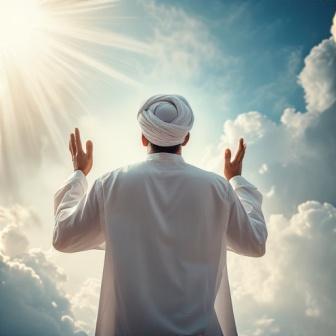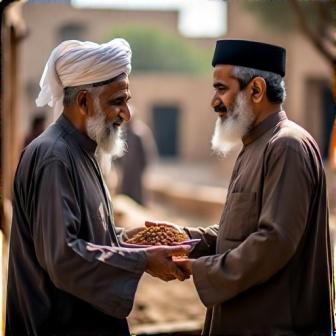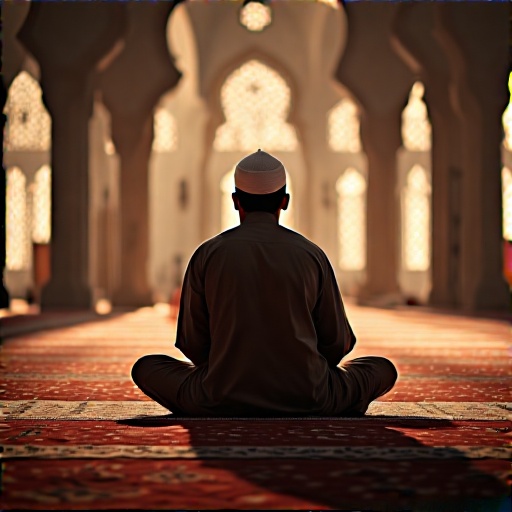Depression – A Human Trial, Not a Faith Failure
Imagine losing everything – your health, wealth, and loved ones – in rapid succession. Now imagine enduring this with unshakeable faith. This was the reality for Prophet Ayyub (عَلَيْهِ ٱلسَّلَامُ), whose legendary patience offers profound lessons for overcoming depression. Depression affects millions today, yet many Muslims suffer silently, fearing it reflects weak faith. Through Quranic verses and authentic Hadith, we will uncover practical spiritual and physical strategies for healing, proving that even the darkest despair can be transformed into hope through submission to Allah (عَزَّ وَجَلَّ).
Understanding Depression in Islam: A Test, Not a Punishment
Depression: A Recognized Human Experience
Islam acknowledges emotional suffering as part of the human condition. Allah (سُبْحَانَهُ وَتَعَالَى) states:
“We have certainly created man into hardship.” (Quran 90:4)
This verse validates life’s inherent struggles. Even prophets – the pinnacle of faith – experienced profound sorrow. Prophet Muhammad (ﷺ) endured the “Year of Sorrow,” losing his wife Khadijah (رَضِيَ ٱللَّٰهُ عَنْهَا) and uncle Abu Talib in quick succession . Prophet Yaqub (عَلَيْهِ ٱلسَّلَامُ) grieved so intensely for his son Yusuf that he lost his eyesight (Quran 12:84). Their experiences prove depression is not a sign of weak faith but a human trial requiring compassionate response.
Allah’s Promise: Ease Follows Hardship
Central to Islamic hope is Allah’s assurance:
“So verily, with hardship, there is ease. Verily, with hardship, there is ease.” (Quran 94:5-6)
The repetition emphasizes certainty. This isn’t passive waiting but active trust that Allah’s plan includes eventual relief. Clinical depression requires professional treatment, yet faith provides a framework for enduring it. As the Quran states: “Allah does not burden a soul beyond what it can bear” (2:286) .
Prophet Ayyub (AS)’s Unimaginable Trials: A Blueprint for Patience
From Blessings to Devastation
Prophet Ayyub (عَلَيْهِ ٱلسَّلَامُ) was initially blessed with enormous wealth, abundant children, and robust health . Yet his life became a cascade of loss:
- Wealth destroyed: Livestock and lands vanished overnight.
- Children killed: All his children perished in a single disaster.
- Health ravaged: A severe illness left him isolated and in agony.
- Social abandonment: His community shunned him, falsely claiming his suffering was divine punishment .
Only his devoted wife remained, selling her hair to buy food and tending his wounds . For 18 years, Ayyub (AS) endured without complaint. When urged to pray for relief, he replied: “Allah gave me 70 years of health. Should I not endure 70 years of hardship?” . This reframes suffering through gratitude – recognizing past blessings amid pain.
The Power of Active Patience (Sabr)
Ayyub’s patience wasn’t passive resignation. It was active worship:
- Gratitude in grief: He thanked Allah for past blessings despite present agony.
- Rejection of despair: He never questioned Allah’s wisdom.
- Dignified endurance: He avoided self-pity or complaint.
Allah praises him:
“Indeed, We found him patient. An excellent servant! Indeed, he constantly turned to Allah.” (Quran 38:44)
The Healing Du’a: How Prophet Ayyub(AS) Called Upon Allah
A Model Supplication for Despair
After years of patience, Ayyub (AS) finally made this heartfelt dua:
“Indeed, adversity has touched me, and You are the Most Merciful of the merciful.” (Quran 21:83)
This dua is revolutionary in its simplicity:
- Acknowledgment without exaggeration: He states his pain factually.
- Focus on Allah’s attribute: He appeals to Divine Mercy, not his own worthiness.
- Surrender over demand: He doesn’t dictate solutions but trusts Allah’s response.
Allah’s Immediate Response
Allah answered by restoring Ayyub (AS)’s health miraculously:
“Strike the ground with your foot; this is a spring for a cool bath and drink.” (Quran 38:42)
Striking the ground released healing water – a symbol that Allah combines spiritual trust with physical action. Ayyub (AS) didn’t just pray; he struck the earth. Similarly, Muslims battling depression must combine dua with practical steps.
Physical and Spiritual Remedies: An Integrated Islamic Approach
Four Prophetic Practices for Mental Wellness
Dhikr (Remembrance of Allah): Reciting “لَا إِلَٰهَ إِلَّا أَنْتَ سُبْحَانَكَ إِنِّي كُنْتُ مِنَ الظَّالِمِينَ” (“There is no deity except You; exalted are You! Indeed, I have been of the wrongdoers” – Quran 21:87) soothes anxiety .
Prayer as Therapy: The Prophet (ﷺ) said: “Prayer is a comfort” (Sahih Muslim 649). Its rhythmic motions and focus induce mindfulness.
Seeking Social Support: Ayyub (AS)’s wife exemplified this. The Prophet (ﷺ) urged community bonds: “Believers are like one body…” (Sahih Muslim 2586).
Professional Treatment: The Quran commands: “Ask those who know” (16:43). Ibn Sina (Avicenna), a Muslim physician, pioneered early psychotherapy. Seeking therapy is obligatory if depression is severe .
Prophets and Companions Who Modeled Resilience
Prophet Yaqub (AS): Grief Managed with Hope
Blinded by tears after losing Yusuf, Yaqub cried:
“I only complain of my suffering and sorrow to Allah” (Quran 12:86)
Yet he never despaired, trusting Allah’s plan. His eventual reunion with Yusuf shows how divine wisdom unfolds beyond human sight.
Prophet Muhammad ﷺ: The Year of Sorrow
After Khadijah’s death, the Prophet (ﷺ) faced rejection in Taif, pelted with stones until he bled. His dua then teaches profound empathy:
“O Allah! Guide my people, for they know not”*
His resilience transformed persecution into the triumphant Hijra.
Abu Bakr’s (رَضِيَ ٱللَّٰهُ عَنْهُ) Anxiety in the Cave
During Hijra, hiding with the Prophet (ﷺ) as enemies neared, Abu Bakr whispered: “If one looked under his feet, he would see us!” The Prophet reassured: “Do not grieve; indeed Allah is with us” (Quran 9:40) . Divine tranquility (Sakina) descended, calming their hearts – a reminder Allah is near in panic attacks.
Dispelling Myths: Depression and Faith in Balance
Myth 1: “Depression Means Weak Faith”
Fact: Prophets experienced profound sadness. The Quran states even the pious are tested: “We will surely test you with fear, hunger, loss…” (2:155). Depression has biological, environmental, and spiritual dimensions – reducing it to “low iman” ignores Islamic complexity .
Myth 2: “Only Prayer is Needed”
Fact: Prophet Ayyub was commanded to act (“Strike with your foot”). The Prophet (ﷺ) said: “Tie your camel and trust in Allah” (Jami` at-Tirmidhi 2517). Muslims must combine prayer with medical care, therapy, and lifestyle changes .
Myth 3: “Suffering is Always Punishment”
Fact: Allah tests those He loves most: “The most severely tested are the prophets…” (Jami` at-Tirmidhi 2398) . Trials purify believers and elevate their ranks.
Practical Steps: Implementing Prophetic Wisdom Today
Five Actionable Tools from the Sunnah
Start Small with Worship: The Prophet (ﷺ) said: “The most beloved deeds to Allah are the most regular, even if small” (Sahih Bukhari 6464). Pray 2 Sunnah rak’ahs daily if 5 feel overwhelming.
Physical Self-Care:
- Move: Walk daily as Ayyub was commanded. The Prophet (ﷺ) walked briskly between Safa and Marwa.
- Hydrate: Drink cool water – Sunnah upon waking.
- Eat Wisely: Dates and honey – Prophet’s foods that stabilize blood sugar.
Reframe Thoughts: When despair whispers “This will never end,” recall: “With hardship comes ease” (94:6). Write past blessings to combat negativity bias.
Build a Support System: Confide in one trusted person as Ayyub (RA) confided in his wife. Join support groups at mosques.
Seek Professional Help: Therapy is Mustahabb (recommended). Many Muslim therapists integrate faith with CBT.
When to Seek Immediate Help
- Suicidal thoughts
- Inability to function for weeks
- Severe weight loss/insomnia
Islam prioritizes preserving life: “Do not throw yourselves into destruction” (2:195).
Conclusion: Your Test, Your Triumph
Prophet Ayyub (RA)’s legacy isn’t just his patience – it’s his transformative recovery. Allah restored his health, multiplied his wealth, and gifted him new children . This symbolizes a profound truth: No pain is wasted in Allah’s economy. Every moment of despair is weighed and will be compensated. Modern depression feels isolating, but you walk a path trodden by prophets. Their stories prove that crying to Allah – like Ayyub (RA)’s raw dua – isn’t weakness; it’s the essence of Tawhid.
Three Reflections to Begin Your Healing:
- Gratitude as Armor: List 3 blessings daily – as Ayyub (RA) recalled 70 years of ease.
- Action as Faith: “Strike your foot” – take one small step (call a therapist, walk outdoors).
- Community as Sustenance: Find your “wife” – someone who stays when others leave.
Allah tested those before you with more severe trials, yet they emerged radiant. Trust that your story, too, will be a beacon for others. Strike the ground. The water is nearer than you think.







